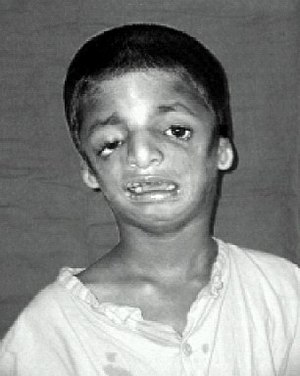Treacher Collins syndrome
| Treacher Collins syndrome | |
|---|---|
| Synonyms | Treacher Collins–Franceschetti syndrome, mandibulofacial dysostosis, Franceschetti-Zwalen-Klein syndrome |
 |
|
| Child with Treacher Collins syndrome | |
| Classification and external resources | |
| Specialty | Medical genetics |
| ICD-10 | Q75.4 |
| ICD-9-CM | 756.0 |
| OMIM | 154500 |
| DiseasesDB | 13267 |
| MedlinePlus | 001659 |
| eMedicine | plastic/183 |
| MeSH | D008342 |
Treacher Collins syndrome (TCS) is an autosomal dominant congenital disorder characterized by craniofacial deformities, involving the ears, eyes, cheekbones, and jawbone. Those affected have normal intelligence. The typical physical features include downward-slanting eyes, micrognathia (a small lower jaw), conductive hearing loss, underdeveloped zygomatic bones, drooping part of the lateral lower eyelids, and malformed or absent ears, but they can vary dramatically between affected people. These physical features can cause problems breathing, hearing, and seeing.
It is most commonly caused by a mutation in the TCOF1 gene, but can also be caused by mutations in POLR1C or POLR1D, all of which are genes involved in the development of the pharyngeal arches and assembly of ribosomes, making Treacher Collins a ribosomopathy. It is diagnosed with a physical examination, though imaging may be used to investigate specific symptoms. Treacher Collins syndrome is not curable, but its symptoms can be managed with reconstructive surgery, hearing aids, and other assistive devices and practices.
TCS occurs in about one in 50,000 births in Europe. The syndrome is named after Edward Treacher Collins (1862–1932), the English surgeon and ophthalmologist who described its essential traits in 1900.
Symptoms in people with Treacher Collins syndrome vary. Some individuals may be so mildly affected that they remain undiagnosed; others can have severe facial involvement and life-threatening airway compromise. Most of the features of TCS are symmetrical and are already recognisable at birth.
...
Wikipedia
